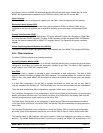
HONEYWELL Aerospace Electronic Systems Page 20
Use or disclosure of information on this page is subject to the restrictions on the title page of this document.
Once an AOC message has been viewed by the flight crew (and any required user action has been taken), it
can be placed in one of 8 user defined review categories. ATC messages have a separate review category.
The flight crew can access messages placed in the review categories at any time.
A useful analogy for ACARS message processing is an email system. When a new email arrives, the user
is alerted ("you have mail") and the message goes into an inbox. Once the message is read, the user will
typically file the message into one of several email folders. The review categories can be thought of as email
folders.
Downlink Processing
The flight crew can create downlink messages to be transmitted to ground systems. As with uplink
messages, the definition of the display format and the downlink message format is defined by the user in the
AMI. The downlink message can include any aircraft parameters defined in the FIDB and specified in the
AMI.
Once all required data is entered on the downlink screen, the SEND prompt becomes active. After selecting
the SEND prompt, the message status transitions to SENDING. The flight crew will be notified of successful
receipt by the ground when the message status transitions to SENT.
A downlink message is placed in a user-defined queue for transmission to the ground. The user can define
the downlink queue based on any number of criteria. For instance, a downlink queue can be defined for a
particular message type. By defining different queues for different message types, a user can ensure
equitable transmission of different message types.
A user is also able to define the preferred subnetwork (and even service provider) to be used for transmitting
a message to the ground. This preference can vary depending upon the current aircraft position. The user
can define regions of the world by specifying a series of latitude and longitude coordinates. For a given
region, the user can then specify the preferred subnetwork and frequency (See Figure 8 for an example). The
baseline subnetworks include VHF (mode 0/A), SATCOM, and HFDL.
Figure 8 World Regions


















